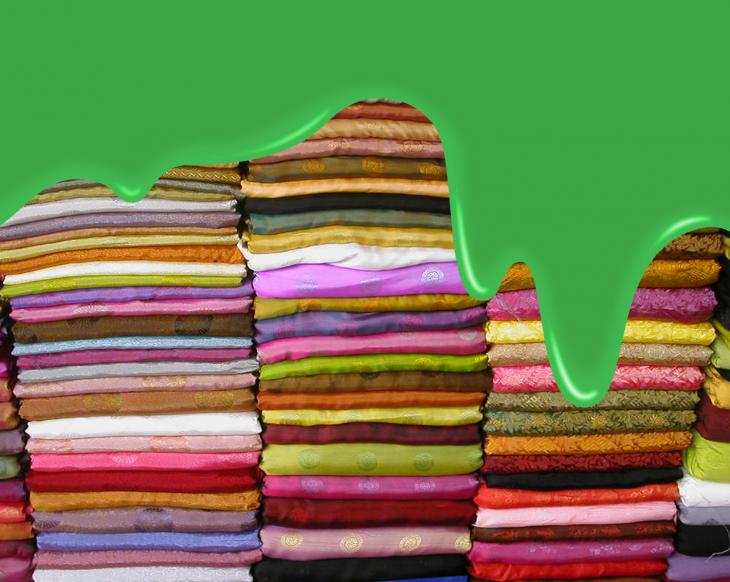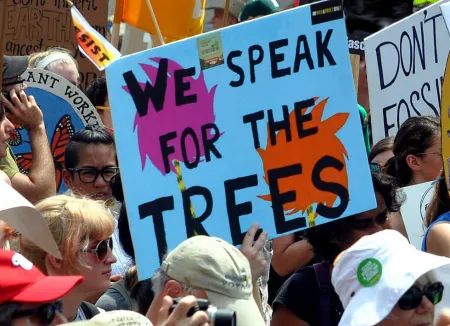A downloadable version of this lesson is available here:
Driven by the rise of fast fashion, consumers have come to expect trendy clothing at low prices. This comes at the cost of garment quality, worker wages, and environmental sustainability. Clothing production has doubled since 2000 while the number of times we wear each garment before disposal has declined by about one third. Greater than 97% of new garments are made from virgin “feedstock,” that is, materials such as cotton or plastic (less than 3% from recycled sources), and nearly three quarters of used garments are trashed or incinerated (MacArthur Foundation audit, 19-20). This wasteful system depends on cheap inputs of petroleum-based fabrics, which impacts ecosystems as microplastics that infiltrate land and water and billions of trashed garments flow into mountainous landfills. As awareness of the current model's unsustainability builds, corporations have taken up the mantle of sustainability, with public displays of their green best practices. Patagonia, an outdoor supply company known for their environmental ethos and innovative design, has long been leading efforts to establish closed loops of repair and recycling, to sell durable items, and to convert production to renewable energy sources. H&M is a leading fast fashion brand with a business model built around the cheap and disposable item. Still, they claim a variety of sustainability measures on their website and pledge to lead revolutions of green design. How much of this public-facing work is greenwashing?
This lesson complements Ecological Restoration and Corporate Greenwashing but is a stand-alone exploration of greenwashing in the fashion industry. In this lesson, learners will review the major findings of the MacArthur Foundation’s audit of the industry and their proposed initiatives. They will also apply the 19 rhetorical tactics of greenwashing from de Freitas Netto et al. (2020) to assess the levels of greenwashing among five major corporations across the garment industry and present their findings to their peers.
- Learn the 19 rhetorical tactics of greenwashing and the four initiatives to transform fashion into a more sustainable industry and apply them to five apparel companies.
- Critically review corporate sustainability websites and establish a range of practices from pure greenwashing to impactful, revolutionary initiatives that reduce environmental impacts.
- Enable levers of governance and oversight by recognizing transparency in marketing and identifying illegal greenwashing practices for FTC enforcement.
-
We all know about Dr. Seuss’ Lorax, who speaks for the trees. His rival the Onceler makes garment “thneeds” and advertises, “You need a thneed!” For 3 minutes, ask learners to share their experience with being marketed to as a consumer.
- Have they ever made elective purchases that they later regretted?
- What social, economic, or marketing pressures do they think influenced their behavior?
- How do they think marketing and advertising strategies could improve to reflect a societal evolution toward more sustainable production and consumption? Have they seen any of these advances taking place?
-
For another minute, ask learners to look at the label in their shirt or pants (they may need to ask a neighbor for assistance, if they are comfortable with that) and note to themselves and their partner:
- Brand name
- Production location
- Fabric composition
- Estimation of the number of times they’ve worn the garment relative to how long they have had it—a lot, a little, or somewhere in between?
- Did any of their observations surprise them?
Greenwashing in the Fashion and Apparel Industry (One 75-minute class, with optional extension)
-
As preparation for class, learners should review the 19 rhetorical tactics of greenwashing from de Freitas Netto et al. (2020). Also have learners read the abridged audit from the MacArthur Foundation, A New Textiles Economy, paying special attention to the highlighted areas and the four ambitions for the industry on pages 23-25. This source presents a highly optimistic view of our ability to revolutionize the textiles industry, so learners should be aware of how idealism can be related to greenwashing—and note the sponsors of the study on page 8.
-
(10 min.) Review the greenwashing tactics as well as major principles of and action steps toward a textile revolution using these lesson PPT slides.
DocumentFashion and Apparel Greenwashing.pptx (5.26 MB) -
(30 min.) Participants will now conduct a comparative analysis of the sustainability practices of major players in the garment industry by reviewing their sustainability (virtue) websites as well as third party sites that have critiqued their practices. They will compare what they find to specific greenwashing tactics outlined by de Freitas Netto et al. (2020) and the initiatives outlined in the article: A New Textiles Economy.
Divide learners into five small groups of three to five individuals and present them with the links provided below.
In-House Sustainability (Virtue) Website
Third Party Review Website
Assign each group a subset of greenwashing rhetorical tactics, from slides #3–7 of the lesson PPT/pages 8–10 of the article (listed below). Ask each group to compile a list of suspected incidents for each tactic across companies by using both the virtue sites and the third party review sites provided. Note that the third party sites are news and popular websites rather than government regulatory agency sites, which presently impose little oversight. They may find their own sources of information, as well, and should note where they found additional information for use in their presentations.
Groups should also simultaneously note the genuine, impactful changes and commitments made by these companies. These advances might be related to the four initiatives in A New Textiles Economy: 1. Reduce hazardous materials and microplastics; 2. Increase clothing durability and use frequency; 3. Design fabrics to be recyclable and use recycled materials; 4. Increase production efficiency and source virgin material sustainably.
- Group 1 will assess tactics #1-4: Hidden Tradeoff, No Proof, Vagueness, Worshiping False Labels
- Group 2 will assess tactics #5-8: Irrelevance, Lesser of Two Evils, Fibbing, False Hopes
- Group 3 will assess tactics #9-12: Fearmongering, Broken Promises, Injustice, Hazardous Consequences
- Group 4 will assess tactics #13-16: Profits over People and the Environment, Dirty Business, Ad Bluster, Political Spin
- Group 5 will assess tactics #17-19: It’s the Law, Stupid!, Fuzzy Reporting, Executional Greenwashing
-
(5 min.) Allow a brief amount of time for groups to prepare their presentations and elect speakers.
-
(25 min.) For the remaining class time, each group has 5 minutes to present their research findings: A comparative sustainability analysis across companies, to include specific examples of greenwashing and what they believe to be highlights of true advances in the sustainability practices of these multinational corporations.
The instructor might probe the participants with questions such as:
- How do they know what they know?
- Do they feel they have enough information, especially about quantitative, measurable, and time-dependent gains in sustainability?
- How does the lack of government regulation affect the rate of progress?
If time remains, the class might discuss the cultural and systemic changes in consumerism needed to bring about revolutions of reduced consumption. This SESYNC lesson details that work.
-
Optional Extension: Dedicate the entirety of the 75-minute session to more in-depth research with the option to use the additional resources and reflection questions below; assign the creation of more robust presentations (~10 min. each) with the use of a shared online platform for homework; and allot time for presentations and discussion in the next class session.
The Sustainable Apparel Coalition describes themselves as a “global multi-stakeholder nonprofit alliance for the consumer goods industry.” License to Greenwash, a report from the Changing Markets Foundation, evaluates and critiques the sustainability claims of this and other "certifying" bodies and voluntary initiatives. Participants could be invited to skim these sites for overall impressions or the instructor could designate specific sections to review.
- Example reflection questions: Are these organizations having an overall positive or negative impact on the sustainability of the apparel industry or somewhere in between? How do participants envision a better path forward?
The Federal Trade Commission (FTC) is a government agency tasked with enforcing antitrust and consumer protection laws. Participants could explore their resources on identifying and reporting greenwashing.
- Example reflection questions: What role do they think this agency plays in the sustainability of the apparel industry? What other government agencies are involved in regulating the apparel industry?
-
Optional In-depth Project: Invite groups that uncover major greenwashing incidents to write an editorial detailing the problem, and seek publication in a newspaper. They may also review the FTC Green Guide, file an FTC complaint on the matter, and follow up to see whether their acute critical oversight prompts changes.
-
These Fast Fashion Brands are Greenwashing
This 16-minute video by Justine Leconte, a fashion designer, details how to recognize greenwashing, which brands are practicing it (including H&M), and tactics to discern true claims from green spin. She discusses ways that consumers can advocate for more transparency and accountability in their transactions with favorite fashion brands.
Leconte, Justine. (2021, April 22). These fast fashion brands are greenwashing | H&M and Primark vs. Fashion Revolution Week [Video]. YouTube. https://www.youtube.com/watch?v=mYkFHMgToeA
-
License to Greenwash: How Certification Schemes and Voluntary Initiatives are Fueling Fossil Fashion
This critical review from the Changing Markets Foundation provides a detailed analysis of how third-party certification groups, including the Sustainable Apparel Coalition and the Ellen MacArthur Foundation, affect actual measurable progress in sustainable revolutions. The authors discuss how the lack of quantitative and time-sensitive accountability are critical failures in this type of certification.
Changing Markets Foundation. (2022). License to Greenwash: How Certification Schemes and Voluntary Initiatives are Fueling Fossil Fashion. http://changingmarkets.org/wp-content/uploads/2022/03/LICENCE-TO-GREENWASH-FULL-REPORT.pdf
-
Making Fashion Sustainable: Waste and Collective Responsibility
This short editorial discusses fast fashion’s environmental footprint and the newer innovations toward achieving more sustainable garment production. The author Debbie Moorhouse stresses circularity, transparency, and shared responsibility between producers and consumers.
Moorhouse, Debbie. (2020). Making Fashion Sustainable: Waste and Collective Responsibility. One Earth, 3(1), 17–19. https://doi.org/10.1016/j.oneear.2020.07.002
-
The Myth of Sustainable Fashion
This accessible article from Harvard Business Review details the shortcomings of sustainability and recycling rhetoric as ways of reducing the true impacts of garment production. Author Kenneth Pucker discusses new business models based on resale and rental, and provides an overview of regulatory agencies that could reduce greenwashing and increase transparency.
Pucker, K.P. (2022, January 13). The Myth of Sustainable Fashion. Harvard Business Review. https://hbr.org/2022/01/the-myth-of-sustainable-fashion
-
‘Vegan,’ ‘sustainable’: How to spot misleading fashion claims
This editorial from The Washington Post provides a quick overview of the most abused and vague marketing terms in fashion parlance, and gives guidelines for assessing a company’s true impacts by critically reading their website’s claims.
Chiu, Allyson. (2023, January 27). ‘Vegan,’ ‘sustainable’: How to spot misleading fashion claims. The Washington Post. https://www.washingtonpost.com/climate-solutions/2023/01/25/greenwashing-fashion-clothes-vegan-sustainable/

